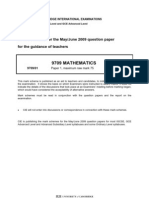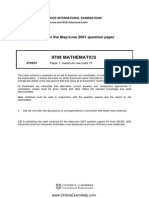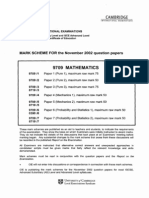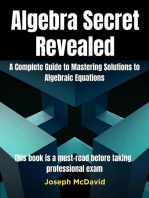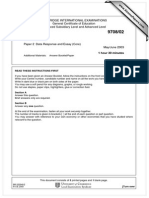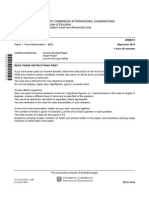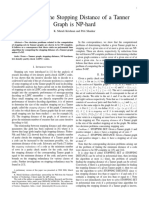9709 s11 Ms 22
9709 s11 Ms 22
Uploaded by
Diksha KoossoolCopyright:
Available Formats
9709 s11 Ms 22
9709 s11 Ms 22
Uploaded by
Diksha KoossoolOriginal Title
Copyright
Available Formats
Share this document
Did you find this document useful?
Is this content inappropriate?
Copyright:
Available Formats
9709 s11 Ms 22
9709 s11 Ms 22
Uploaded by
Diksha KoossoolCopyright:
Available Formats
w w w e tr .
X m ap eP
UNIVERSITY OF CAMBRIDGE INTERNATIONAL EXAMINATIONS
GCE Advanced Subsidiary Level and GCE Advanced Level
s er om .c
MARK SCHEME for the May/June 2011 question paper for the guidance of teachers
9709 MATHEMATICS
9709/22 Paper 2, maximum raw mark 50
This mark scheme is published as an aid to teachers and candidates, to indicate the requirements of the examination. It shows the basis on which Examiners were instructed to award marks. It does not indicate the details of the discussions that took place at an Examiners meeting before marking began, which would have considered the acceptability of alternative answers. Mark schemes must be read in conjunction with the question papers and the report on the examination.
Cambridge will not enter into discussions or correspondence in connection with these mark schemes.
Cambridge is publishing the mark schemes for the May/June 2011 question papers for most IGCSE, GCE Advanced Level and Advanced Subsidiary Level syllabuses and some Ordinary Level syllabuses.
Page 2 Mark Scheme Notes
Mark Scheme: Teachers version GCE AS/A LEVEL May/June 2011
Syllabus 9709
Paper 22
Marks are of the following three types: M Method mark, awarded for a valid method applied to the problem. Method marks are not lost for numerical errors, algebraic slips or errors in units. However, it is not usually sufficient for a candidate just to indicate an intention of using some method or just to quote a formula; the formula or idea must be applied to the specific problem in hand, e.g. by substituting the relevant quantities into the formula. Correct application of a formula without the formula being quoted obviously earns the M mark and in some cases an M mark can be implied from a correct answer. Accuracy mark, awarded for a correct answer or intermediate step correctly obtained. Accuracy marks cannot be given unless the associated method mark is earned (or implied). Mark for a correct result or statement independent of method marks.
When a part of a question has two or more "method" steps, the M marks are generally independent unless the scheme specifically says otherwise; and similarly when there are several B marks allocated. The notation DM or DB (or dep*) is used to indicate that a particular M or B mark is dependent on an earlier M or B (asterisked) mark in the scheme. When two or more steps are run together by the candidate, the earlier marks are implied and full credit is given. The symbol implies that the A or B mark indicated is allowed for work correctly following on from previously incorrect results. Otherwise, A or B marks are given for correct work only. A and B marks are not given for fortuitously "correct" answers or results obtained from incorrect working. Note: B2 or A2 means that the candidate can earn 2 or 0. B2/1/0 means that the candidate can earn anything from 0 to 2.
The marks indicated in the scheme may not be subdivided. If there is genuine doubt whether a candidate has earned a mark, allow the candidate the benefit of the doubt. Unless otherwise indicated, marks once gained cannot subsequently be lost, e.g. wrong working following a correct form of answer is ignored. Wrong or missing units in an answer should not lead to the loss of a mark unless the scheme specifically indicates otherwise. For a numerical answer, allow the A or B mark if a value is obtained which is correct to 3 s.f., or which would be correct to 3 s.f. if rounded (1 d.p. in the case of an angle). As stated above, an A or B mark is not given if a correct numerical answer arises fortuitously from incorrect working. For Mechanics questions, allow A or B marks for correct answers which arise from taking g equal to 9.8 or 9.81 instead of 10.
University of Cambridge International Examinations 2011
Page 3
Mark Scheme: Teachers version GCE AS/A LEVEL May/June 2011
Syllabus 9709
Paper 22
The following abbreviations may be used in a mark scheme or used on the scripts: AEF AG BOD CAO CWO ISW MR PA SOS SR Any Equivalent Form (of answer is equally acceptable) Answer Given on the question paper (so extra checking is needed to ensure that the detailed working leading to the result is valid) Benefit of Doubt (allowed when the validity of a solution may not be absolutely clear) Correct Answer Only (emphasising that no "follow through" from a previous error is allowed) Correct Working Only - often written by a fortuitous' answer Ignore Subsequent Working Misread Premature Approximation (resulting in basically correct work that is insufficiently accurate) See Other Solution (the candidate makes a better attempt at the same question) Special Ruling (detailing the mark to be given for a specific wrong solution, or a case where some standard marking practice is to be varied in the light of a particular circumstance)
Penalties
MR -1
A penalty of MR -1 is deducted from A or B marks when the data of a question or part question are genuinely misread and the object and difficulty of the question remain unaltered. In this case all A and B marks then become "follow through " marks. MR is not applied when the candidate misreads his own figures - this is regarded as an error in accuracy. An MR-2 penalty may be applied in particular cases if agreed at the coordination meeting. This is deducted from A or B marks in the case of premature approximation. The PA -1 penalty is usually discussed at the meeting.
PA -1
University of Cambridge International Examinations 2011
Page 4 1
Mark Scheme: Teachers version GCE AS/A LEVEL May/June 2011
Syllabus 9709
Paper 22 M1* A1 M1 dep* A1 [4]
Attempt use of power law for logarithms Obtain xlog3 = xlog2 + 2log2 or equivalent Attempt solution for x of linear equation Obtain 3.42
(i) Show or imply correct ordinates 1, 2 or 1.414, 3 Use correct formula, or equivalent, with h = 1 Obtain 3.41
B1 M1 A1
[3]
(ii) Obtain 6 3.41 and hence 2.59, following their answer to (i) provided less than 6 B1 Refer, in some form, to two line segments replacing curve and conclude with clear justification of given result that answer is an under-estimate. B1 3 (i) Use the iteration process correctly at least once Obtain at least two correct iterates to 5 decimal places Conclude = 0.952 [1 0.95647 0.95257 0.95223 0.95220] (ii) State or imply equation is x = Obtain 8x3 x2 6 = 0 M1 A1 A1
[2]
[3]
13 2 x +6 2
B1 B1 [2]
1 (a) Obtain integral form of k cos x 2 1 Obtain correct 2 cos x 2 Use limits correctly to obtain 1
(b) Rewrite integrand as ex + 1 Integrate to obtain ex Integrate to obtain + x + c
M1 A1 A1 B1 B1 B1 [3]
[3]
Obtain 4 y
dy as derivative of 2y2 dx
B1
Differentiate LHS term by term to obtain expression including at least one Obtain 2 x + 4 y
dy dy +5+6 dx dx
dy dx
M1 A1
Substitute 2 and 1 to attempt value of Obtain
9 2 Obtain equation 9x + 2y 16 = 0 or equivalent of required form
dy dx
M1 A1 A1 [6]
University of Cambridge International Examinations 2011
Page 5 6
Mark Scheme: Teachers version GCE AS/A LEVEL May/June 2011
Syllabus 9709
Paper 22 M1 A1 M1 A1 A1 M1 A1 M1 M1 A1 M1 A1 M1 A1 A1
(i) Attempt differentiation using product rule Obtain 8 x ln x + 4 x (a.c.f.) Equate first derivative to zero and attempt solution Obtain 0.607 Obtain 0.736 following their x-coordinate (ii) Use an appropriate method for determining nature of stationary point Conclude point is a minimum (with no errors seen, second derivative = 8)
[5] [2]
(i) Substitute x = 2 and equate to zero Substitute x = 1 and equate to 24 Obtain 4a 2b = 38 and a b = 20 or equivalents Attempt solution of two linear simultaneous equations (dependent on M1 M1) Obtain a = 1 and b = 21 (ii) Attempt to find quadratic factor by division, inspection or use of identity Obtain 6x2 13x + 5 Conclude (x + 2 )(2 x 1)(3 x 5)
[5]
[3]
(i) Use cosec =
1 1 and sec = sin cos Attempt to simplify left-hand side Confirm given right-hand side 4cos2 with no errors seen 3 4 Attempt correct process to find at least one angle Obtain 20.7 Obtain 159.3 and no others in range
4 cos 30o sin 2 30o
B1 M1 A1 B1 M1 A1 A1 B1 B1 [2] [3]
(ii) (a) State or imply cos2 =
[4]
(b) Recognise as Obtain 8 3
University of Cambridge International Examinations 2011
You might also like
- II Puc Maths MCQ (Part - A)Document44 pagesII Puc Maths MCQ (Part - A)Vansh Gupta100% (3)
- Quadratic Equations in One Unknown (A)Document66 pagesQuadratic Equations in One Unknown (A)luk matthewNo ratings yet
- HESI A2 Math Practice Tests: HESI A2 Nursing Entrance Exam Math Study GuideFrom EverandHESI A2 Math Practice Tests: HESI A2 Nursing Entrance Exam Math Study GuideNo ratings yet
- 9709 Mathematics: MARK SCHEME For The May/June 2011 Question Paper For The Guidance of TeachersDocument6 pages9709 Mathematics: MARK SCHEME For The May/June 2011 Question Paper For The Guidance of TeachersJia SyuenNo ratings yet
- Regents Exams and Answers Geometry Revised EditionFrom EverandRegents Exams and Answers Geometry Revised EditionNo ratings yet
- Data Interpretation Guide For All Competitive and Admission ExamsFrom EverandData Interpretation Guide For All Competitive and Admission ExamsRating: 2.5 out of 5 stars2.5/5 (6)
- Chapter I-Complex Numbers&VariablesDocument10 pagesChapter I-Complex Numbers&VariablesMico Marvin YturzaetaNo ratings yet
- 9709 w11 Ms 32Document7 pages9709 w11 Ms 32Helen B. EvansNo ratings yet
- 9709 w09 Ms 32Document7 pages9709 w09 Ms 32Alex Antia0% (1)
- 9709 s05 Ms 3 PDFDocument10 pages9709 s05 Ms 3 PDFtess_15No ratings yet
- Math 9709 - s11 - Ms - 62Document6 pagesMath 9709 - s11 - Ms - 62purni.mnath4574No ratings yet
- 9709 Mathematics: MARK SCHEME For The May/June 2010 Question Paper For The Guidance of TeachersDocument6 pages9709 Mathematics: MARK SCHEME For The May/June 2010 Question Paper For The Guidance of TeachersDiksha KoossoolNo ratings yet
- 9709 Mathematics: MARK SCHEME For The May/June 2009 Question Paper For The Guidance of TeachersDocument8 pages9709 Mathematics: MARK SCHEME For The May/June 2009 Question Paper For The Guidance of TeachersSeleine ChongNo ratings yet
- 9709 s09 Ms 7Document13 pages9709 s09 Ms 7Mohamed Fouad KorraNo ratings yet
- 9709 w12 Ms 33Document7 pages9709 w12 Ms 33Nicholas TehNo ratings yet
- 9709 s05 Ms 1Document9 pages9709 s05 Ms 1Halıl UskuriNo ratings yet
- 9709 s11 Ms 12Document7 pages9709 s11 Ms 12Diksha KoossoolNo ratings yet
- 9709 s09 Ms 1Document6 pages9709 s09 Ms 1Thapa GorkhaNo ratings yet
- 9709 s05 Ms 6 PDFDocument8 pages9709 s05 Ms 6 PDFtess_15No ratings yet
- 9709 s11 Ms 62 PDFDocument6 pages9709 s11 Ms 62 PDFMehreen Al Li YahNo ratings yet
- June 2010 (v1) MS - P3 CIE Maths A-LevelDocument6 pagesJune 2010 (v1) MS - P3 CIE Maths A-LevelZi QianNo ratings yet
- 9709 w14 Ms 61Document6 pages9709 w14 Ms 61MuhammadIbrahimNo ratings yet
- A Levels Statistics 1 Marking Scheme /63Document6 pagesA Levels Statistics 1 Marking Scheme /63Joel DavidNo ratings yet
- 9709 s05 Ms 1 PDFDocument9 pages9709 s05 Ms 1 PDFtess_15No ratings yet
- 9709 w11 Ms 63Document6 pages9709 w11 Ms 63Mushfiqur RahmanNo ratings yet
- 9709 s13 Ms 73 PDFDocument6 pages9709 s13 Ms 73 PDFDiksha KoossoolNo ratings yet
- MARK SCHEME For The November 2005 Question Paper: University of Cambridge International ExaminationsDocument5 pagesMARK SCHEME For The November 2005 Question Paper: University of Cambridge International ExaminationsIslamAltawanayNo ratings yet
- 9709 s05 Ms 4 PDFDocument9 pages9709 s05 Ms 4 PDFDinishNo ratings yet
- 9709 s15 Ms 72 PDFDocument6 pages9709 s15 Ms 72 PDFSanthiKalyanaGrantNo ratings yet
- 9709 s10 Ms 22Document5 pages9709 s10 Ms 22Hubbak KhanNo ratings yet
- 9709 Mathematics: MARK SCHEME For The March 2016 SeriesDocument7 pages9709 Mathematics: MARK SCHEME For The March 2016 SerieswircexdjNo ratings yet
- 9709 s06 Ms 1Document6 pages9709 s06 Ms 1Amr AboulkhairNo ratings yet
- 9709 s10 - ms31Document118 pages9709 s10 - ms31ShoummaShamsNo ratings yet
- 9709 Oct Nov 2011 All Mark SchemesDocument130 pages9709 Oct Nov 2011 All Mark SchemesRaisa Binte Huda100% (1)
- 9709 Mathematics: MARK SCHEME For The May/June 2007 Question PaperDocument6 pages9709 Mathematics: MARK SCHEME For The May/June 2007 Question PaperIqra JawedNo ratings yet
- 9709 s15 Ms 62Document6 pages9709 s15 Ms 62Abrar JahinNo ratings yet
- June 2016 (v2) MS - P1 CIE Maths A-LevelDocument8 pagesJune 2016 (v2) MS - P1 CIE Maths A-LevelSnookayNo ratings yet
- 9709 s07 Ms 1 PDFDocument6 pages9709 s07 Ms 1 PDFtess_15No ratings yet
- 4037 w21 Ms 12Document25 pages4037 w21 Ms 12Zahra LamiaNo ratings yet
- Cambridge Assessment International Education: Mathematics 9709/31 May/June 2018Document11 pagesCambridge Assessment International Education: Mathematics 9709/31 May/June 2018osama ansariNo ratings yet
- 9709 Mathematics: MARK SCHEME For The October/November 2009 Question Paper For The Guidance of TeachersDocument6 pages9709 Mathematics: MARK SCHEME For The October/November 2009 Question Paper For The Guidance of TeachersManjunath JyothinagarNo ratings yet
- 9709 s10 Ms 21Document5 pages9709 s10 Ms 21Hubbak KhanNo ratings yet
- University of Cambridge International ExaminationsDocument5 pagesUniversity of Cambridge International ExaminationsHubbak KhanNo ratings yet
- 9709 s04 MsDocument34 pages9709 s04 MsFaris ČakarićNo ratings yet
- 9709 w03 MsDocument33 pages9709 w03 Msmichael hengNo ratings yet
- Cambridge Assessment International Education: Mathematics 9709/41 May/June 2018Document10 pagesCambridge Assessment International Education: Mathematics 9709/41 May/June 2018Andrei CristescuNo ratings yet
- AQA GCSE Mathematics Unit 3H MS Practice Papers Set 4 v1.1Document14 pagesAQA GCSE Mathematics Unit 3H MS Practice Papers Set 4 v1.1naz2you100% (4)
- As Levels Pure Mathematics 1Document8 pagesAs Levels Pure Mathematics 1Sin GeeNo ratings yet
- 9709 Mathematics: CambridgeDocument8 pages9709 Mathematics: CambridgeanzaaariNo ratings yet
- Mark Scheme (Results) January 2014: Pearson Edexcel International GCSE Further Pure Mathematics (4PM0/01) Paper 1Document24 pagesMark Scheme (Results) January 2014: Pearson Edexcel International GCSE Further Pure Mathematics (4PM0/01) Paper 1Lalith77No ratings yet
- A Level Maths November 2012 Mark Scheme 12Document7 pagesA Level Maths November 2012 Mark Scheme 12Kelvin MuzaNo ratings yet
- 9709 w10 Ms 11Document7 pages9709 w10 Ms 11Joseph Dj-mo KellyNo ratings yet
- Real Estate Math Express: Rapid Review and Practice with Essential License Exam CalculationsFrom EverandReal Estate Math Express: Rapid Review and Practice with Essential License Exam CalculationsNo ratings yet
- Practice Tests for CASAS Math GOAL 2 Level C, Forms 925M and 926MFrom EverandPractice Tests for CASAS Math GOAL 2 Level C, Forms 925M and 926MNo ratings yet
- Practice Makes Perfect: Algebra II Review and Workbook, Third EditionFrom EverandPractice Makes Perfect: Algebra II Review and Workbook, Third EditionNo ratings yet
- Algebra Secret RevealedComplete Guide to Mastering Solutions to Algebraic EquationsFrom EverandAlgebra Secret RevealedComplete Guide to Mastering Solutions to Algebraic EquationsNo ratings yet
- Let's Review Regents: Algebra II Revised EditionFrom EverandLet's Review Regents: Algebra II Revised EditionRating: 5 out of 5 stars5/5 (1)
- 0606 s07 QP 2Document8 pages0606 s07 QP 2Sherlock Wesley ConanNo ratings yet
- 9706 w12 Ms 23Document7 pages9706 w12 Ms 23Diksha KoossoolNo ratings yet
- 9709 s13 QP 73 PDFDocument4 pages9709 s13 QP 73 PDFDiksha KoossoolNo ratings yet
- 9709 s13 Ms 73 PDFDocument6 pages9709 s13 Ms 73 PDFDiksha KoossoolNo ratings yet
- 9709 s13 QP 51Document4 pages9709 s13 QP 51Diksha KoossoolNo ratings yet
- Nora Roberts List of BooksDocument26 pagesNora Roberts List of BooksDiksha Koossool50% (2)
- 9709 s13 Ms 73 PDFDocument6 pages9709 s13 Ms 73 PDFDiksha KoossoolNo ratings yet
- 9709 s11 Ms 12Document7 pages9709 s11 Ms 12Diksha KoossoolNo ratings yet
- 9709 s11 Ms 12Document7 pages9709 s11 Ms 12Diksha KoossoolNo ratings yet
- 9709 s13 QP 72Document4 pages9709 s13 QP 72Diksha KoossoolNo ratings yet
- 9708 s04 QP 4Document4 pages9708 s04 QP 4Diksha KoossoolNo ratings yet
- 9708 s03 QP 1Document12 pages9708 s03 QP 1Diksha KoossoolNo ratings yet
- 9709 w10 QP 32Document4 pages9709 w10 QP 32Diksha KoossoolNo ratings yet
- 9708 s04 QP 3 PDFDocument12 pages9708 s04 QP 3 PDFTawanda B MatsokotereNo ratings yet
- 9708 s03 QP 2Document4 pages9708 s03 QP 2Diksha KoossoolNo ratings yet
- 9708 s11 QP 22Document4 pages9708 s11 QP 22avishna14No ratings yet
- 9709 w12 QP 12Document4 pages9709 w12 QP 12Aj AgenNo ratings yet
- Aqa Chm6w W QP Jun02Document18 pagesAqa Chm6w W QP Jun02Diksha KoossoolNo ratings yet
- 9708 s04 QP 1Document12 pages9708 s04 QP 1Diksha KoossoolNo ratings yet
- 9709 s13 QP 11Document4 pages9709 s13 QP 11Diksha KoossoolNo ratings yet
- Lebesgue MeasureDocument4 pagesLebesgue MeasureJose Luis Condori100% (1)
- Annexure-37. MSC Mathematics Sep 4 2018Document51 pagesAnnexure-37. MSC Mathematics Sep 4 2018Avani YadavNo ratings yet
- Game TheoryDocument28 pagesGame Theoryshreya5319100% (1)
- Amt SyllabusDocument3 pagesAmt SyllabusArijeet DasNo ratings yet
- Computing The Stopping Distance of A Tanner Graph Is NP-hardDocument4 pagesComputing The Stopping Distance of A Tanner Graph Is NP-hardMARCELONo ratings yet
- Aa HLDocument8 pagesAa HLavy.lee.25No ratings yet
- Quant Checklist 225 PDF 2022 by Aashish Arora PDFDocument103 pagesQuant Checklist 225 PDF 2022 by Aashish Arora PDFPritee TomarNo ratings yet
- Werner & Sonne (1947) - The Philosophy and Theory of Music in Judaeo-Arabic LiteratureDocument70 pagesWerner & Sonne (1947) - The Philosophy and Theory of Music in Judaeo-Arabic LiteratureSusan Vaughan100% (1)
- hw1 Solution 16 PDFDocument17 pageshw1 Solution 16 PDFOsho AgrawalNo ratings yet
- A Set Is An Ordered Collection of ObjectsDocument2 pagesA Set Is An Ordered Collection of Objects在于在No ratings yet
- Mathematics10 Q2 Mod22 V1.0Document24 pagesMathematics10 Q2 Mod22 V1.0Bridget SaladagaNo ratings yet
- NUET 2022 Mathematics Specimen PaperDocument26 pagesNUET 2022 Mathematics Specimen Papernyry2005100% (1)
- UB2009 - Worksheet20bDocument2 pagesUB2009 - Worksheet20bblahgzNo ratings yet
- Module 1 Limits and ContinuityDocument35 pagesModule 1 Limits and ContinuityFabie BarcenalNo ratings yet
- The Discrete Logarithm Problem - René Schoof (2016)Document13 pagesThe Discrete Logarithm Problem - René Schoof (2016)Trần Minh KhoaNo ratings yet
- DivyaDocument13 pagesDivyaGovindramNo ratings yet
- DAA MID2 (UandiStar - Org)Document27 pagesDAA MID2 (UandiStar - Org)Rikki RevsNo ratings yet
- CvxoptDocument2 pagesCvxoptAristeidis AlexopoulosNo ratings yet
- Matas MSER PDFDocument10 pagesMatas MSER PDFTomislav LivnjakNo ratings yet
- Quadratic EquationDocument5 pagesQuadratic Equationafoo1234No ratings yet
- Or Mcq..Document7 pagesOr Mcq..Soul LyricsNo ratings yet
- Lecture 2Document11 pagesLecture 2waleedNo ratings yet
- 2021 Fall AMC 10A ProblemsDocument4 pages2021 Fall AMC 10A Problemsjasperwei4002No ratings yet
- Subtraction of FractionsDocument13 pagesSubtraction of FractionsAkia AlexisNo ratings yet
- Polynomial FunctionsDocument9 pagesPolynomial FunctionsLaurenzhen SorianoNo ratings yet
- Osmania PG Exams Postponed: Download Revised Time TableDocument23 pagesOsmania PG Exams Postponed: Download Revised Time TableMruthyunjayNo ratings yet
- TD2 - Sets Operations - Relations and ApplicationsDocument2 pagesTD2 - Sets Operations - Relations and ApplicationsalexenbuzNo ratings yet


















